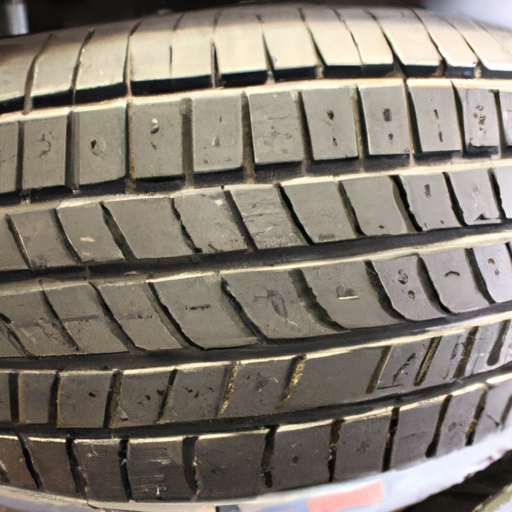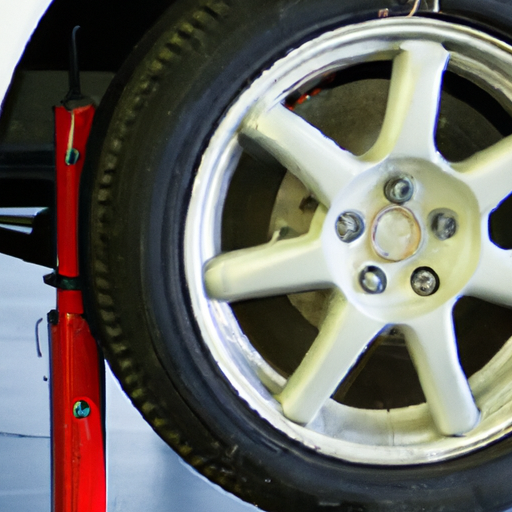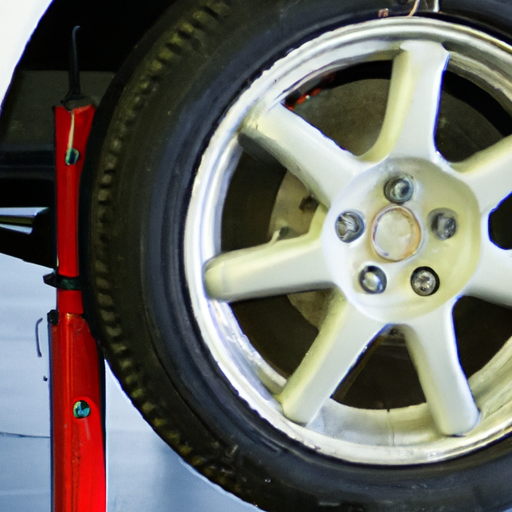Are you experiencing any strange vibrations while driving? Have you noticed uneven tire wear or your car pulling to one side? If so, you may have wheel alignment issues. In this article, we will explore the common signs that indicate your wheels are misaligned. From steering wheel vibrations to unusual tire patterns, understanding these signs will help you take proactive steps to ensure your vehicle’s safety and longevity.
Uneven Tire Wear
Cupping
If you notice that your tires have a scalloped or cupped appearance, it is a clear indication of an alignment issue. Cupping occurs when the tire tread wears down unevenly, creating a series of low and high spots. This can happen due to worn-out shocks or struts, imbalanced tires, or suspension problems. When you have cupped tires, you may experience a bumpy ride, noticeable vibrations, or even a humming noise as you drive.
Feathering
Feathering is another common sign of wheel alignment problems. It refers to the tires wearing down in a feather-like pattern, with the outside or inside edge of the tread being significantly more worn than the rest. This can occur when the wheels are not properly aligned, resulting in the tires “scrubbing” against the road. Feathering can cause increased road noise, reduced traction, and less overall tire life. It is essential to address this issue promptly to avoid further damage and potentially costly tire replacements.
Scalloped
Scalloped tire wear, also known as “cupping,” manifests as small, scooped depressions along the tread pattern. This irregular wear pattern can be caused by a variety of factors, such as improper tire rotation, imbalanced wheels, or suspension problems. Scalloping not only compromises the tire’s performance but also poses safety risks. When you drive with scalloped tires, you may experience a vibration, increased road noise, or even difficulty maintaining control of your vehicle. Regular tire rotations and proper wheel alignment can help prevent scalloping and prolong the life of your tires.
Vehicle Pulling to One Side
When braking
If your vehicle pulls to one side when you apply the brakes, it is a sign of wheel alignment issues. When the wheels are misaligned, they exert different forces on each side, causing the vehicle to pull to the side with the greater force. This can be caused by uneven brake pad wear, caliper problems, or suspension issues. Pulling to one side while braking not only affects your vehicle’s stability but also poses safety risks, especially during emergency stops. This problem should not be ignored and should be promptly addressed by a professional mechanic to ensure your safety on the road.
During driving
When your vehicle constantly pulls to one side, even when you are not braking, it indicates wheel alignment problems. This pulling sensation can be caused by misaligned wheels, unequal tire pressure, or suspension issues. Driving with a vehicle that pulls to one side not only affects your driving experience but also puts you at risk of losing control on slippery or uneven surfaces. If you notice this issue, it is crucial to have your wheel alignment checked and corrected by a trained technician to ensure proper handling and safety.
When accelerating
Experiencing a pull to one side while accelerating can also be a sign of wheel alignment issues. When the wheels are misaligned, they can cause uneven traction on the road, resulting in the vehicle pulling to one side during acceleration. This can be caused by worn-out suspension components, uneven tire wear, or imbalanced wheels. A consistent pull to one side while accelerating not only affects your driving experience but can also lead to premature tire wear and decreased fuel efficiency. Having your alignment checked and corrected will help restore balance and stability to your vehicle.

Steering Wheel Vibration
At high speeds
If your steering wheel vibrates at high speeds, it may be indicative of wheel alignment problems. Vibrations can occur when the wheels are not properly aligned, causing uneven tire wear and an imbalanced wheel assembly. This can result in an uncomfortable driving experience and, in severe cases, can even make it challenging to maintain control of your vehicle. Addressing the alignment issue and ensuring proper wheel balance can help eliminate these vibrations, providing you with a smooth and safe ride.
During braking
Experiencing steering wheel vibrations when applying the brakes can be a clear sign of wheel alignment issues. Misaligned wheels can cause uneven brake pad wear and rotor warping, resulting in vibrations being transmitted to the steering wheel when the brakes are applied. These vibrations can range from mild to severe, depending on the extent of the alignment problem. It is crucial to have your alignment checked and any necessary repairs made to ensure proper brake performance and a smooth, controlled braking experience.
Crooked Steering Wheel
Off-center position
If your steering wheel is consistently off-center, it is a sign that your wheels are not properly aligned. When the wheels are misaligned, they can cause the steering wheel to deviate from its centered position, even when driving straight. This can be caused by worn steering components, improper alignment adjustments, or suspension issues. Driving with a crooked steering wheel not only affects your vehicle’s aesthetics but can also lead to increased tire wear and decreased steering responsiveness. It is essential to have your alignment checked and adjusted to ensure your vehicle is properly aligned and safe to drive.
Misaligned logo or emblem
Another sign of wheel alignment issues is a misaligned logo or emblem on your steering wheel. If you notice that the logo or emblem is not aligned with the centerline of your vehicle, it is an indication of a misalignment problem. This can occur due to worn steering components, incorrect alignment adjustments, or even prior collision damage. While a misaligned logo may seem like a minor issue, it can be a red flag for underlying alignment issues that should be addressed to ensure proper steering functionality and alignment.

Difficulty Steering
Stiff steering
If you find it difficult to turn the steering wheel, it may be a result of wheel alignment problems. Misaligned wheels can cause increased friction and resistance within the steering system, making it harder to turn. Stiff steering can be caused by worn-out steering components, lack of lubrication, or suspension issues. Struggling to turn the steering wheel not only affects maneuverability but can also lead to driver fatigue and potentially compromise your ability to react quickly in emergency situations. Having your alignment checked and any necessary repairs made will help restore ease of steering and enhance your driving experience.
Loose steering
On the other hand, if your steering feels loose or less responsive than usual, it can also be an indication of wheel alignment issues. Misaligned wheels can result in poor wheel tracking and reduced stability, leading to a sensation of the steering wheel being unresponsive or disconnected from the road. Loose steering can be caused by worn-out steering components, lack of proper alignment adjustments, or suspension problems. Driving with loose steering compromises your vehicle’s handling and increases the risk of losing control, especially when navigating turns or encountering sudden changes in road conditions. Addressing the alignment issue will help restore proper steering responsiveness and enhance your overall driving safety.
Squealing Tires
While turning
If you hear your tires squealing while turning, it can be a sign of wheel alignment problems. Misaligned wheels can cause uneven tire wear, which can result in reduced traction during cornering. This can lead to tire squealing as the tires struggle to maintain grip on the road. Squealing tires while turning not only affect your vehicle’s performance but also indicate a potential loss of control, especially on wet or slippery surfaces. It is crucial to have your alignment checked and any necessary adjustments made to ensure proper tire contact with the road, preventing tire squealing and ensuring optimal handling.
Under normal driving conditions
If your tires squeal even during normal driving conditions, it is a sign that your wheels may be misaligned. When the wheels are not aligned correctly, the tires can experience uneven wear, resulting in reduced traction and squealing noises. This can occur due to various factors, including tire pressure imbalances, suspension problems, or lack of regular tire rotations. Squealing tires under normal driving conditions not only affect your comfort but also pose safety risks, as reduced traction can lead to loss of control. Having your alignment checked and any necessary adjustments made will help eliminate tire squealing, ensuring a smoother and safer driving experience.

Uneven Brake Wear
Inconsistent brake pad wear
If you notice that your brake pads are wearing unevenly, it is a clear indication of wheel alignment issues. Misaligned wheels can cause one brake pad to make more contact with the rotor than the other, resulting in uneven wear. This can lead to compromised braking performance, increased stopping distances, and potential safety risks. Addressing the alignment issue promptly and replacing the brake pads will help restore proper braking functionality and ensure your safety on the road.
Uneven rotor wear
Uneven wear on your brake rotors can also indicate wheel alignment problems. When the wheels are misaligned, the brake rotor can be subjected to uneven forces, causing it to wear unevenly. This can result in pulsating brakes, decreased braking performance, and potential safety hazards. If you notice that your brake rotors have uneven wear patterns or are significantly worn, it is essential to have your alignment checked and any necessary repairs completed to ensure optimal braking performance and your overall safety.
Increased Fuel Consumption
Poor wheel alignment causing drag
One often overlooked consequence of wheel alignment issues is increased fuel consumption. When the wheels are misaligned, they can create additional drag on the vehicle, requiring more energy to move forward. This increased resistance means your engine has to work harder and burn more fuel to compensate. If you notice a significant decrease in fuel efficiency, even when driving under normal conditions, it is advisable to have your alignment checked and corrected. Proper wheel alignment will reduce drag, improve fuel efficiency, and save you money at the gas pump.
Increased rolling resistance
Misaligned wheels can result in increased rolling resistance, another contributing factor to higher fuel consumption. Rolling resistance refers to the force required to keep the tires rolling smoothly on the road surface. When your wheels are not properly aligned, this resistance increases, requiring more energy and fuel to propel the vehicle forward. If you find that you need to fill up your tank more frequently than usual, despite no changes in driving habits or conditions, it may be time to have your alignment checked. Resolving wheel alignment issues will reduce rolling resistance, improve fuel economy, and help you save on your overall fuel costs.

Tire Damage or Blowouts
Sidewall damage
If you notice significant damage or bulges on your tire’s sidewall, it can be an indication of wheel alignment problems. Misaligned wheels can cause uneven tire wear and abnormal stresses on the sidewall, leading to damage and potential blowouts. Sidewall damage is a serious safety concern, as it compromises the structural integrity of the tire and increases the risk of sudden tire failure. If you observe any signs of sidewall damage, such as cuts, bulges, or blisters, it is crucial to have your alignment checked and any necessary tire replacements made to ensure your safety on the road.
Blowouts due to excessive wear
Wheel alignment problems can contribute to excessive and uneven tire wear, which can eventually lead to tire blowouts. When the wheels are misaligned, they exert uneven forces on the tires, causing certain areas to wear out faster than others. This can weaken the tire’s structure, making it more prone to sudden blowouts, especially during high-speed driving or when encountering road hazards. To prevent tire blowouts, it is essential to have your alignment checked regularly and promptly address any alignment issues. By maintaining proper alignment, you can extend the life of your tires and ensure a safer driving experience.
Excessive Steering Wheel Movements
Overcompensating while driving straight
If you find yourself constantly adjusting the steering wheel while driving straight to keep your vehicle on track, it is likely due to wheel alignment issues. Misaligned wheels can cause your vehicle to pull or drift to one side, leading to overcompensating steering movements to stay in your lane. Overcompensating not only affects your driving comfort but also poses safety risks as it can lead to sudden swerving or veering into other lanes. Having your alignment checked and corrected will ensure your vehicle drives straight and reduces the need for constant steering corrections.
Difficulty keeping the vehicle in a straight line
When your vehicle struggles to maintain a straight line without excessive steering input, it indicates wheel alignment issues. Misaligned wheels can cause your vehicle to drift to one side or feel unstable, making it challenging to keep it on a straight path. This can be caused by worn suspension components, improper alignment adjustments, or tire pressure imbalances. Difficulty keeping your vehicle in a straight line not only affects your driving experience but also increases the risk of veering into oncoming traffic or obstacles. Addressing the alignment issue will help restore stability and ensure safer and more controlled driving.


